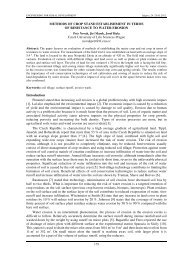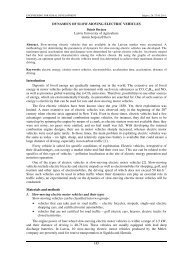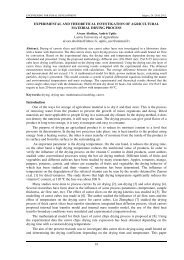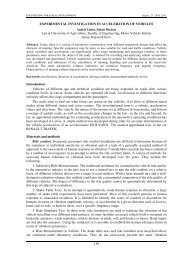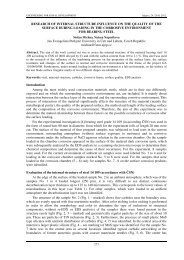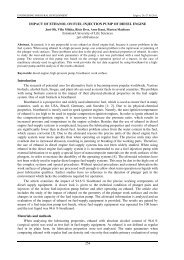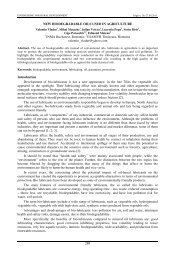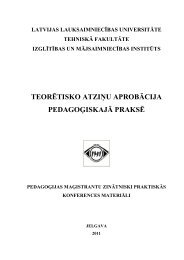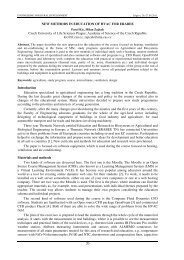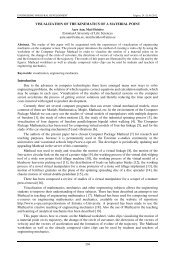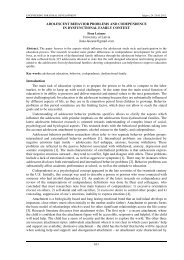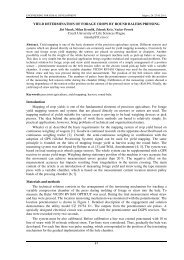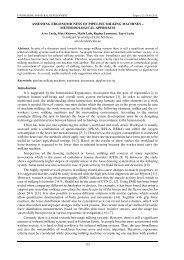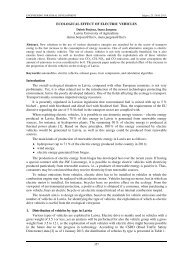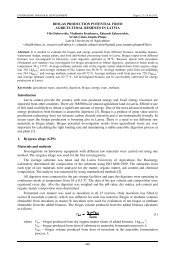Igors Tipans, Semjons Cifanskis, Janis Viba, Vladimirs Jakushevich ...
Igors Tipans, Semjons Cifanskis, Janis Viba, Vladimirs Jakushevich ...
Igors Tipans, Semjons Cifanskis, Janis Viba, Vladimirs Jakushevich ...
You also want an ePaper? Increase the reach of your titles
YUMPU automatically turns print PDFs into web optimized ePapers that Google loves.
ENGINEERING FOR RURAL DEVELOPMENT Jelgava, 26.-27.05.2011.<br />
(<br />
L<br />
∫<br />
0<br />
2<br />
( ⋅ξ<br />
) ⋅ξ<br />
⋅ dξ )<br />
ϕ& – component of moment of resistance force like integral along tail<br />
direction;<br />
̇φ – angular velocity;<br />
L – length of the tail.<br />
From theorem of tail mass m centre motion follows (8) (Fig. 6.):<br />
⎛ 2 L<br />
L ⎞<br />
m ⋅ ⎜ & ϕ ⋅ ⋅ cosϕ<br />
+ && ϕ ⋅ ⋅ sinϕ<br />
⎟ = Ax − k<br />
⎝ 2<br />
2 ⎠<br />
After integration from equations (6) and (7) we have (9, 10):<br />
2 L 1<br />
Ax = m ⋅{<br />
& ϕ ⋅ ⋅ cos( ϕ)<br />
+<br />
2 J<br />
t<br />
⎛<br />
⋅ B ⋅ sin( ϕ)<br />
⋅ sign(<br />
ϕ ⋅ & ϕ)<br />
⋅ ⎜<br />
⎝<br />
L<br />
∫<br />
0<br />
⎞<br />
2<br />
( & ϕ ⋅ξ<br />
) ⋅ dξ<br />
⎟ ⎠<br />
4<br />
1 ⎡<br />
2 L ⎤<br />
& ϕ<br />
= ⋅ ⎢M<br />
( t,<br />
ϕ,<br />
& ϕ)<br />
− c ⋅ϕ<br />
− k ⋅ B ⋅ sign(<br />
&<br />
t<br />
ϕ)<br />
⋅ & ϕ ⋅ ⎥<br />
(9)<br />
J<br />
A ⎣<br />
4 ⎦<br />
3<br />
2 L<br />
+ kt<br />
⋅ B ⋅ sin( ϕ)<br />
⋅ sign(<br />
ϕ ⋅ & ϕ)<br />
⋅ & ϕ ⋅ .<br />
3<br />
A<br />
⎡<br />
⋅ ⎢M<br />
( t,<br />
ϕ,<br />
& ϕ)<br />
− c ⋅ϕ<br />
− k<br />
⎣<br />
Then the criterion of optimization (fool impulse) is:<br />
T<br />
K = −∫<br />
0<br />
⎛<br />
2 L 1 ⎡<br />
⎜m<br />
⋅{<br />
& ϕ ⋅ ⋅ cos( ϕ)<br />
+ ⋅ M ( t,<br />
, ) c k<br />
2 J<br />
⎢ ϕ & ϕ − ⋅ϕ<br />
−<br />
t<br />
⎜<br />
A ⎣<br />
⎜<br />
3<br />
⎜<br />
2 L<br />
+ kt<br />
⋅ B ⋅sin(<br />
ϕ)<br />
⋅ sign(<br />
ϕ ⋅ & ϕ)<br />
⋅ & ϕ ⋅<br />
⎝<br />
3<br />
t<br />
(8)<br />
4<br />
2 L ⎤ L<br />
⋅ B ⋅ sign(<br />
& ϕ)<br />
⋅ & ϕ ⋅ ⋅ ⋅ sin( )} +<br />
4<br />
⎥ ϕ<br />
⎦ 2<br />
(10)<br />
4<br />
2 L ⎤<br />
⋅ B ⋅ sign(<br />
& ϕ)<br />
⋅ & ϕ ⋅<br />
4<br />
⎥ ⋅<br />
⎦<br />
L ⎞<br />
⋅sin(<br />
ϕ)}<br />
+ ⎟<br />
2 ⎟<br />
⎟⋅<br />
dt.<br />
(11)<br />
⎟<br />
⎠<br />
The last equations (11) can be used in the task of optimizations. The solution of optimal control<br />
problem for the system with one degree of freedom (9) by using the maximum principle of Portryaing<br />
may be found out from equations (6, 7) [6-10]. Like before, the control action is on the bounds<br />
boundaries (5).<br />
Synthesis of system with adaptive excitation and adaptive area control<br />
In a case of adaptive excitation moment M may be used like a function of angular velocity in a<br />
form [3; 9] M(t)=M0·sign(ω). The results of modelling are shown in Fig. 7-10.<br />
ω n<br />
0<br />
0.5<br />
0.25<br />
0<br />
-0.25<br />
-0.5<br />
-0.3 -0.15 0 0.15 0.3<br />
Fig. 7. Tail angular motion in phase plane –<br />
angular velocity as function of angle<br />
ϕ n<br />
ε n<br />
4<br />
2.6<br />
1.3<br />
0<br />
-1.33<br />
-2.67<br />
-4<br />
-0.3 -0.2 -0.1 0 0.1 0.2 0.3<br />
ϕ n<br />
Fig. 8. Angular acceleration of tail as<br />
function of angle<br />
461



